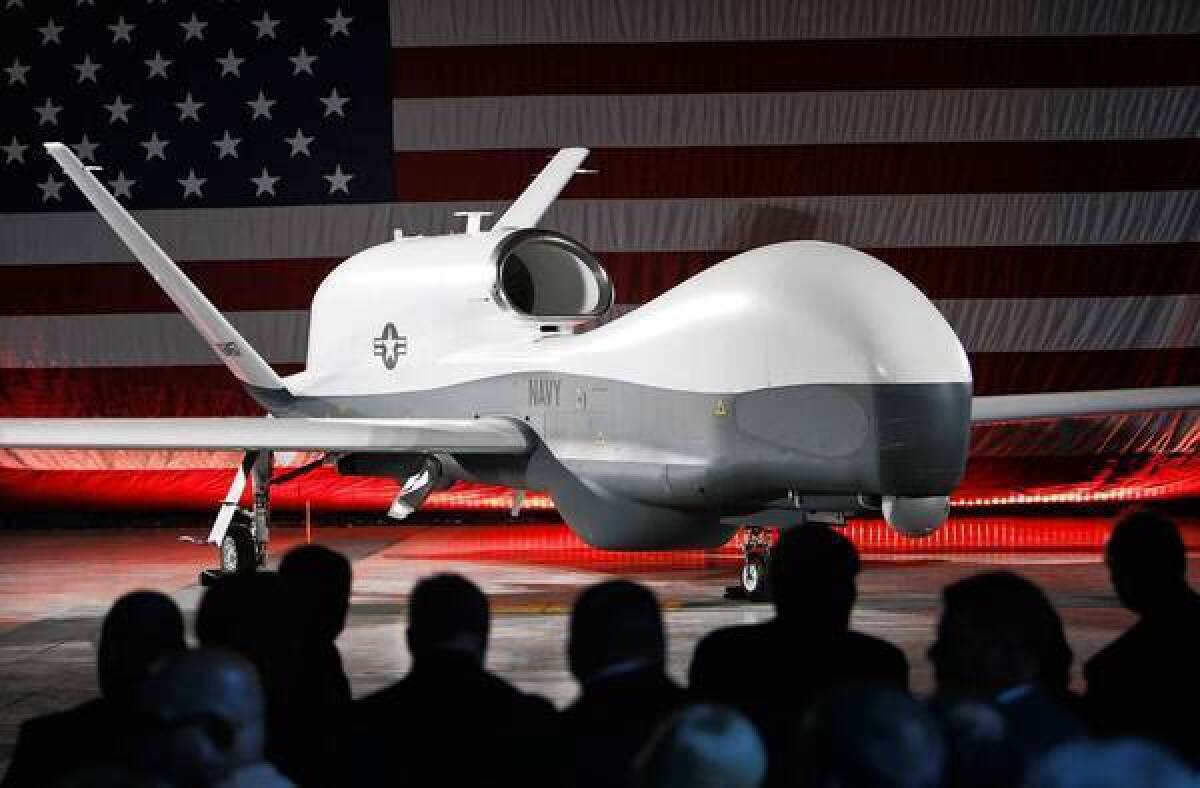Drone makers urge U.S. to let them sell more overseas

Despite concerns about U.S.-made drones ending up in enemy hands, American military contractors are lobbying the government to loosen export restrictions and open up foreign markets to the unmanned aircraft that have reshaped modern warfare.
Companies such as Northrop Grumman Corp.and other arms makers are eager to tap a growing foreign appetite for high-tech â and relatively cheap â drones, already being sold on the world market by countries such as Israel and China.
âExport restrictions are hurting this industry in America without making us any safer,â Wesley G. Bush, Northropâs chief executive, said at a defense conference this year. âThe U.S. is struggling to sell unmanned aircraft to our allies while other nations prepare to jump into the marketplace with both feet.â
The defense industry may want to sell more drones overseas, but arms control advocates are alarmed. The potential for these weapons to fall into enemy hands is great, they say, and easing restrictions could result in remote-controlled killing machines being used in some of the most volatile regions of the world.
Daryl Kimball, executive director of the Arms Control Assn., said that drone sales are problematic because the unmanned vehicles are more affordable than other military aircraft. And with no human pilot at risk, drones could make it easier to decide to go to war, he said.
âThe proliferation of this technology will mark a major shift in the way wars are waged,â he said. âWeâre talking about very sophisticated war machines here. We need to be very careful about who gets this technology. It could come back to hurt us.â
As the U.S. war effort draws down and the Pentagon budget shrinks, defense companies say they need Congress to ease restrictions so they can tap lucrative foreign markets for their wares.
More important, they say, the current export restrictions may cause the U.S. to lose potential customers to nations eager to elbow their way into the market. Already, Israel is making drones and selling them to several countries, including Azerbaijan, India and Ecuador. China has more than a dozen drones in development.
The world appetite for drones will be vividly on display next week at the Farnborough International Airshow in England, one of the largest aerospace showcases.
While American aerospace firms are expected to brag about their usual big sales of commercial jets, attack helicopters and fighter planes, they will have to sit idly by and watch as foreign countries work to land lucrative deals for fresh batches of drones.
The Congressional Research Service warned this year that foreign competitors are getting a jump on U.S. firms.
âMuch new business is likely to be generated in the market, and if U.S. companies fail to capture this market share, European, Russian, Israeli, Chinese or South African companies will,â the research service wrote in its January report. âAs part of its defense and foreign policy oversight, Congress may examine whether a balance must be struck between supporting legitimate U.S. exports and curbing the spread of [drone] technologies to dangerous groups or countries.â
The U.S. already sells fighter jets, bunker-busting bombs and high-powered ship-mounted guns to a wide variety of countries.
But drone sales have been largely prohibited since a 1987 agreement reached by a group called the Missile Technology Control Regime. This group, which initially consisted of the U.S., Canada, France, Germany, Italy, Japan and Britain, has grown to include 34 countries.
There have been a few exceptions for sales over the years, but the agreement put restrictions on the export of any larger pilotless flying aircraft â blimps, helicopters, jets â that can carry 1,102 pounds for more than 186 miles at a time. Drones smaller than these are allowed to be sold.
The primary focus of the agreement was to control the spread of ballistic missiles and other weapons capable of mass destruction.
It was signed during the Cold War â the days when drone aircraft were still largely the stuff of science fiction, said Peter W. Singer, a fellow at the Brookings Institution and author of âWired for War,â a book about robotic warfare.
âWhat we face now is a matter of catching up 20th century ideas and laws to 21st century realities,â he said.
Rep. Howard L. Berman(D-Los Angeles), ranking Democrat on the House Foreign Affairs Committee, said the Obama administration has begun an initiative to change export rules that will roll back many of the restrictions on the way technology is sold to foreign countries.
He expects drone sales to be addressed before his committee this year.
âItâs crazy for us to shut off sales in this area while other countries push ahead,â Berman said. âA very significant part of this economic recovery depends on exports. We need to take advantage of where our strengths lie.â
But, he said, any change to U.S. export controls should be done cautiously and not at the risk of compromising national security.
Meanwhile, drone makers are starting to deal with the current restrictions by designing smaller, unarmed models that are lighter in weight to meet the agreement specifications.
General Atomics Aeronautical Systems Inc., which builds the MQ-1 Predator and MQ-9 Reaper hunter-killer drones used by the Air Force and CIA, has designed a new drone that is subject to looser export restrictions: an unarmed version of the Predator.
The drone, called the Predator XP, could be used for intelligence, surveillance and reconnaissance missions, among other functions.
The San Diego-area company expects to sell the drone to the United Arab Emirates this year. General Atomics would not comment on the details of the potential deal, but it acknowledged growing overseas demand.
In its latest assessment of the industry, aerospace research firm Teal Group Corp. estimated that worldwide drone spending will almost double over the next decade, to $11.4 billion in 2022 from $6.6 billion next year.
Phil Finnegan, a Teal Group analyst who helped put together the study, said the growth in overseas spending makes sense because the Pentagon has spent the last decade building up its drone fleet to nearly 7,500 aircraft. Many foreign countries are just beginning to build their fleets.
âDefense contractors know that demand in the U.S. is expected to flatten out,â he said. âThe real growth will be in international markets.â
In particular, he said, Asia and Latin America will be strong markets.
Thatâs precisely where government-owned Israel Aerospace Industries is operating: It has offices in India, Colombia and Ecuador, among other countries.
Israel is not a partner in the Missile Technology Control Regime. Israel Aerospace Industries, better known as IAI, has been making drones since the late 1970s and has sold them to several countries. The company, which also makes missile and electronic systems, disclosed in its financial statements that 78% of its $3.4 billion in sales came from exports.
âThereâs no doubt about it,â said Doron Suslik, the companyâs vice president of corporate communications. Drones âare one of the core business areas. IAI has expanded our sales to many other countries to make deals.â
These are not new concerns for the aerospace industry. In a recent report, the Aerospace Industries Assn. pointed out that the industry saw a drop in satellite sales after the U.S. put tight restrictions on the export of satellite technology.
The trade group concluded that from 1999 to 2009, the restrictions cost the U.S. 9,000 jobs and up to $21 billion in lost revenue. Its report said the U.S. held 73% of the worldwide share of satellite exports in 1995. But 10 years later, after export controls took effect, the U.S. market share fell to 25%.
âThereâs a risk of following down the same roadâ with drones, said Remy Nathan, the groupâs vice president of international affairs. âThe export restrictions were put into place for good reasons, but it requires some tweaks to include the technology advancements of today.â
More to Read
Inside the business of entertainment
The Wide Shot brings you news, analysis and insights on everything from streaming wars to production â and what it all means for the future.
You may occasionally receive promotional content from the Los Angeles Times.











